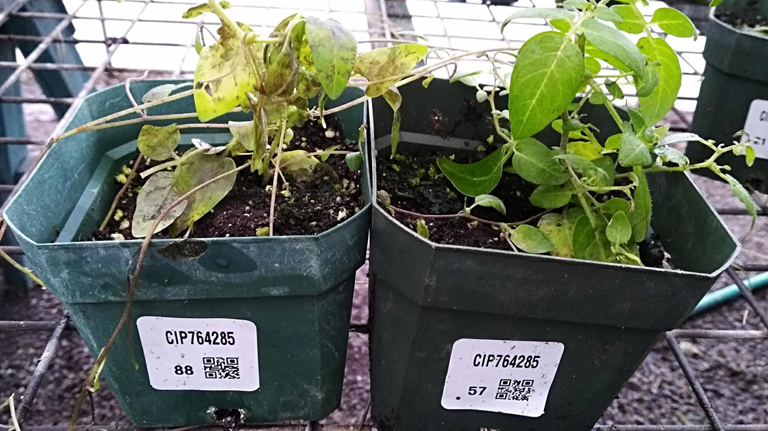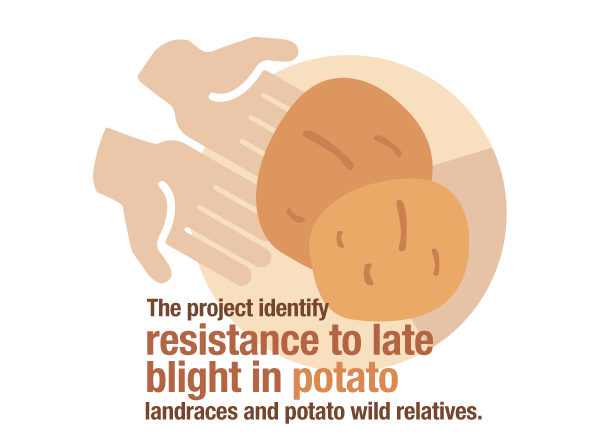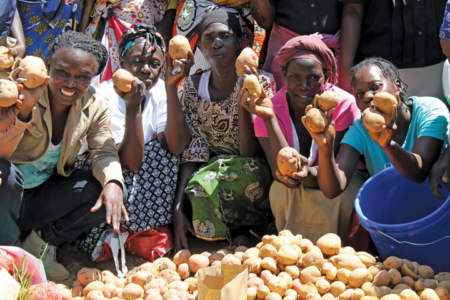
Screening for resistance to late blight in Peruvian wild potato species and traditional landraces: A key contribution to improve farmer livelihoods in Peru and globally
Late blight disease in potato is possibly the most devastating crop disease in history. This project seeks to identify new sources of resistance in landraces and wild relatives, which could be used in potato breeding programs around the world to mitigate the risk of future disease outbreaks.
Background
The Irish potato famine was responsible for around 1 million deaths and caused mass emigration in the mid-1800s. The culprit was an outbreak of late blight disease. The disease devastated the crop since only a limited number of late blight resistant varieties had been cultivated. This lesson remains relevant today, with scientists continuing to focus on maintaining or increasing the genetic diversity of staple crops like potato, thereby mitigating the risk of mass yield losses.
CIP scientists have been working on late blight for decades and have already incorporated sources of resistance from wild relatives into their breeding programs. However, the late blight pathogen thrives in warm, humid conditions and can develop new strains that overcome existing resistance. It is, therefore, important to have a broad range of resistance genes available for use in potato breeding, especially as we face warmer conditions due to climate change.
This project builds on prior work to evaluate collections of potato landraces and wild relatives for new sources of resistance to late blight disease. The sources identified will be used in breeding programs to build the resilience of farmers in Peru and around the world.
Objectives
The project’s goal is to identify resistance to late blight in potato landraces and potato wild relatives by fulfilling the following objectives:
- To evaluate the phenotypes of potato landraces and South American wild Solanaceae species related to potato for resistance to late blight, and make the information publicly available through CIP’s genebank information system and public databases; and
- To increase capacities of national agricultural research systems, universities; and non-governmental organizations to evaluate potato germplasm for resistance to late blight.
Approach
Conducted at CIP headquarters in Lima, the project team screened 352 potato landraces and 57 accessions from 30 potato wild relatives for resistance to late blight. The project also included a capacity-building program for national partners in Peru, including the hosting of a workshop providing hands-on training on pathogen management, inoculation and evaluation. Two BSc students also received scientific support to help them complete their theses.
Although this research will be conducted under experimental station conditions, the results of the project will have gender implications since women are mostly in charge of conserving biodiversity in the Peruvian highlands. In addition, gender was considered during capacity-building activities by promoting the participation of women and young people.
Expected outcomes
The identified resistant potato landraces will be disseminated to smallholders who had already participated in CIP development projects in the Andes, and to indigenous communities in Peru, where late blight presents a significant problem. This dissemination is likely to be accomplished within one to three years after the resistant varieties have been identified. Within three to five years, the new varieties should be ready for distribution throughout Peru. Wider distribution of the wild relatives (as progenitors) and resistant clones to international breeding programs should be accomplished within three to ten years. The project, therefore, has potential to benefit millions of farmers across the world by contributing to the development of improved varieties.
Achievements
Scientists found that six accessions of wild potato species were highly resistant to P. infestans late blight disease: Solanum albornozii (CIP761164), S. andreanum (CIP763108), S. lesteri (CIP764265), S. longiconicum (CIP763966), S. morelliforme (CIP764293), and S. stenophyllidium (CIP763861). They also identified 45 accessions of potato landraces which displayed levels of resistance to those present in a resistant control variety (Pallay Poncho). In addition, two women students who participated in the project in part fulfillment of their degrees in Peruvian universities organized a seminar on Exploring resistance to the oomycete pathogen Phytophthora infestans, with support from key scientists at CIP, United States Department of Agriculture and the University of Minnesota.
Key outputs
| Key outputs | Key figures |
| N°. of farmers receiving resistant landraces | 1,000 |
| New varieties ready for release in Peru | 3–5 years |
| Distribution of parent potato clones to breeding programs in other countries | 3–10 years |
Contact
Jorge Andrade-Piedra
CIP, Peru
j.andrade@cgiar.org
Thanks to our donors





